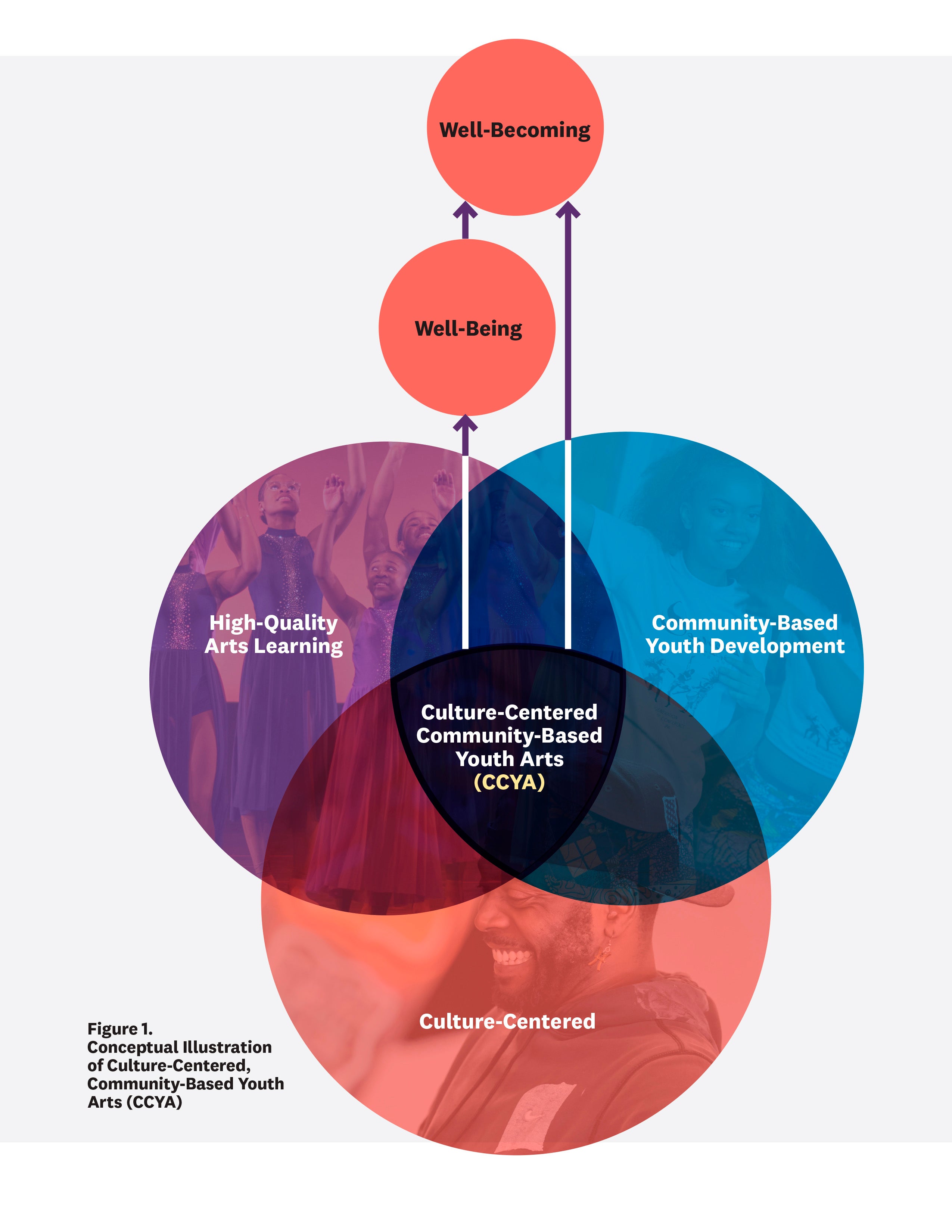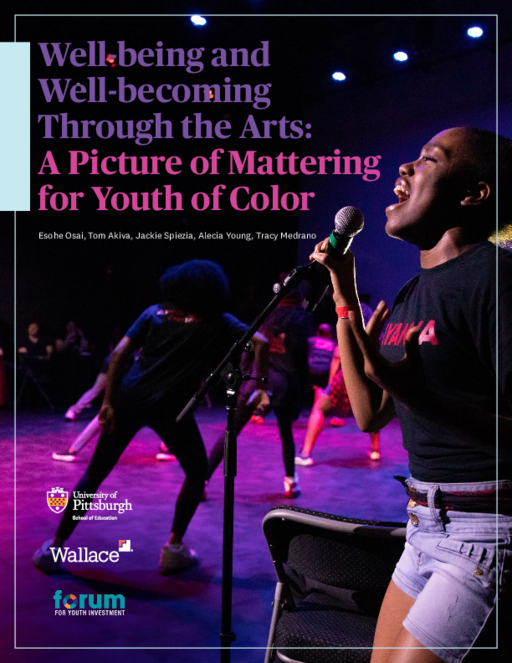Breadcrumb
- Wallace
- Reports
- Well-Being And Well-Becoming Thr...
Well-being and Well-becoming Through the Arts
A Picture of Mattering for Youth of Color

- Author(s)
- Esohe Osai, Tom Akiva, Jackie Spiezia, Alecia Young, and Tracy Medrano
- Publisher(s)
- University of Pittsburgh and Forum for Youth Investment
Summary
How we did this
The research team conducted an 18-month, multi-method study of 35 youth arts organizations designed by, for, and with communities of color across eight U.S. cities—Atlanta, Chicago, Detroit, Louisville, Newark/Paterson, Oakland, Tacoma, and Washington, D.C. Using interviews, focus groups, youth surveys, program observations, and interactive participant-centered activities, the team identified common program design choices intended to support the particular needs and interests of participating youth from communities of color.
As fewer and fewer schools offer arts learning opportunities, out-of-school time organizations in many communities have stepped in to fill that space. This is particularly true in neighborhoods with low income and diverse populations, where robust arts programs are least likely to be present in schools.
A team of researchers at the University of Pittsburgh set out to explore the values and goals that these community-based arts organizations brought to the design of their programs. Through their work they have defined them as “culture-centered, community-based youth arts programs.” They have identified seven program design characteristics and a range of reported positive youth outcomes.
What are culture-centered, community-based youth arts programs?
Culture-centered, community-based youth arts (CCYA) programs integrate high-quality arts learning experiences with community-based youth development practices and culturally sustaining approaches. The programs are designed to provide young people with opportunities for belonging, identity affirmation, and skill development through the arts. Participating youth, their families, and teaching artists report that the programs foster both the well-being of youth and set them up for the future.
Through their interviews with staff and participants in CCYA programs, researchers confirmed that participants often experience joy, a sense of accomplishment, and a growth in confidence and significance through their engagement in the arts. These characteristics can promote a young person's well-being, which encompasses holistic factors like mental and physical health or the social dimensions of life satisfaction. They also promote what the researchers call “well-becoming,” which is movement towards a desirable future state. This could help such illuminate academic, workforce, or interest-driven pathways.
The study identified seven characteristics of ways that culture-centered community-based youth arts programs support well-being and well-becoming:
- Nurture Artistic Skill Programs provide creative communities that develop skill and confidence in the arts
- Cultivate Creative Restoration Programs engage youth’s minds and bodies in creative expressions that promote positive emotions
- Establish Artful Sanctuaries Programs create sanctuaries for connection with artistic peers and adults
- Foster Generative Connections Programs engage deeply with broader communities through performance and resource sharing
- Highlight Meaningful Pathways Programs support pathways into becoming an adult who appreciates and values the arts
- Promote Cultural Visibility Programs acknowledge, affirm, and celebrate the past, present, and future of people of color
- Emphasize Equity Intentionality Programs disrupt racial and economic barriers to arts experiences for youth of color
The study also documented how CCYA programs exist within learning and development ecosystems, which researchers defined as dynamic collections of people, places, and possibilities that impact arts learning experiences. Additionally, programs can be affected by social and cultural histories, support for teaching artists, community support, and the diverse array of arts offered.
Communities and programs are also interconnected: Communities support programs, programs support communities, and program collaboration strengthens the learning ecosystem.
The researchers recommend that CCYA programs should receive more attention in research, policy, funding, and practice. Programs should also receive increased support for teaching artists. Like most out-of-school professionals, teaching artists are generally underpaid, leading to high turnover and likely a dilution of program strengths. This study highlights the need to elevate the pivotal roles of teaching artists and these types of programs.

A class with us isn’t where it stops. It’s only a tool that you take with you to open the doors and change the things you want to change in your world, and see that you do have power and you matter.
— A program leader from Oakland
Key Takeaways
- Well-being and, by extension, well-becoming can help support learning and development experiences that matter for youth of color as they grow into more confident and connected versions of themselves.
- Culture-centered, community-based programs integrate cultural connections, promote representation, and offer a pathway for youth to envision a more just society while feeling valued and seen.
- Employing program staff and leadership teams that reflect the ethnic and cultural identities of youth, along with investing in artists from local neighborhoods, can foster healthy adult-youth mentorship that builds trust and social belonging.
Visualizations
Mapping Culture-Centered, Community-Based Youth Arts

Materials & Downloads
What We Don't Know
- This exploratory research identified positive youth outcomes associated with design elements, which needs to be further tested in future studies.
- Could these findings, developed in the context of programs designed for youth from communities of color, be relevant to youth from other identity groups including intersectional identity groups?

